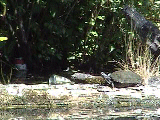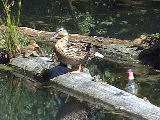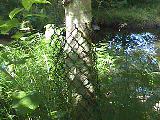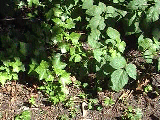An article in Pacific Northwest Magazine discussing Seattle’s recurrent Canada goose problems got me thinking. Cities are primarily for people, and they have their own microenvironments. Some animals and plants thrive inside these ecosystems, and some do not. Creatures that can live among us already do. Attempts to introduce other species to please our sensibilities will more often than not turn into expensive failures or chronic damage-control exercises.


Another example of this is the decade-long effort by Seattle citizen groups to reintroduce coho salmon to Thornton creek. My daughter and I recently visited the outlet to this creek, where it empties into Lake Washington. We were greeted by orange signs warning us not to go near the water because of high levels of coliform bacteria. There was also a bad smell in the air. My daughter’s reaction, “Gross!” We saw ducklings and a turtle sunning on a log. I took some pictures. Note the whiskey bottle by the ducks and the beer can and coke bottle behind the turtle. The turtle’s shell was matted with algae, which is unusual and probably the result of living in the pond fed by the polluted creek. Turtles bask in the sun to obtain vitamin D, which is essential for the health of their shells. This turtle had better find a cleaner place to hang, and soon.


Several trees had been wrapped with steel fencing to protect them from beavers. You can bet that a lot of energy is being expended to tear down dams, and that the city will soon be looking for ways to get rid of these beavers as it is now doing with the geese.
We looked at the many plantings of native species, salal, huckleberry, etc. A question came to mind: Without constant diligence, won’t they quickly disappear again? Acres of blackberry vines intermingled with English ivy cover the ground just a few feet from these plantings.


After having spent millions of dollars, with millions more on the way, the creek still has problems normally associated with open sewers. A couple of years ago it was realized that most returning coho salmon were being poisoned shortly after entering the creek (see the video).
Each car in a city drips oil, antifreeze, grease, transmission and brake fluid. Yards contain dog poop, weed killers, slug death, rat poison, insecticides, and fertilizers. It was standard practice in the last half-century to dump one’s used motor oil into one’s yard in areas where weeds needed to be controlled. Some people still do it.
All of this goes from the street to the nearest stream or lake as surface runoff. Many of us would like to live in a city side by side with native wildlife and plants, but sometimes there is a practical limit to what can be accomplished.



